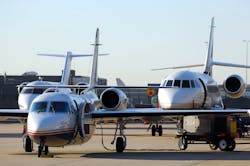In the Post-Pandemic World, General Aviation is Taking Off
While the COVID-19 pandemic dealt a devastating blow to aviation across the globe, it also caused a resurgence in one key sector of the industry – general aviation. In many markets, general aviation activity returned to normal by December 2020. And, at many of the nation’s airports, operations are currently soaring beyond pre-pandemic levels.
According to FlightAware, a provider of real-time and historical flight information, business aviation traffic in the U.S. boomed in 2021, rising above 2019 numbers. As the general aviation industry continues to rebound from the pandemic, 2022 already shows a nearly 22 percent increase above the same time period in 2019.
What is propelling this growth in the general aviation industry? Major contributors include increased flight training, charter activity, relocation or remote work situations, and investment.
Flight Training
First, FAA statistics indicate the number of licensed pilots in the U.S. has increased every year since 2016, with 2021 having the highest number of pilots over the past 30 years. For example, last year the FAA recorded a total of 720,605 active airmen certificates held, compared to 691,691 in 2020, 664,565 in 2019 and 633,317 in 2018.
It is important to remember that every commercial pilot, regardless of whether they are pursuing a career in the military or with an airline, begins as a private pilot. Airlines are ramping up recruiting and training programs due to pilot shortages, and are offering attractive salary and benefits packages to students coming out of a growing number of collegiate training programs.
Also, according to the “FAA Aerospace Forecast Fiscal Years 2021-2041,” the general aviation sector was less affected by the COVID-19 crisis than the airlines. There are new entrants to the high-end business jet segment, as well as new student, private and commercial pilots joining the general aviation pilot population. Many are flying piston aircraft out of airports that do not have as many commercial flights due to the pandemic. This makes the long-term outlook for general aviation more promising than before.
Charter Activity
Another continuing trend is for businesses to transport employees to in-person meetings and events via private aviation, by either chartering aircraft, investing in a company-owned aircraft or opting for a fractional ownership program. With the U.S. and other parts of the world moving COVID-19 from being a pandemic to an endemic, both commercial airline and general aviation activity are expected to increase.
However, flying privately in smaller aircraft continues to hold many advantages, such as presenting a lower health risk when compared to a commercial airline flight filled with hundreds of potential virus-spreading passengers. The elimination of federal mask mandates on transportation networks may also drive general aviation activity.
Relocation and Remote Work Opportunities
Third, with many businesses providing remote work opportunities, many individuals are relocating from urban areas to smaller communities. This trend to move away from major urban centers, and farther away from major airline hubs, increases the desirability, flexibility and freedom of mobility that come with general aviation.
Notably, this movement to suburban and rural communities is resulting in increased demand at the nation’s general aviation airports – presenting the challenge of how to accommodate long-term operational and facility needs. As a result, many airport sponsors are gearing up to make major investments in infrastructure improvements and capital projects.
Aviation Investment
Finally, the general aviation industry is attracting venture capitalists to the emerging air mobility market (UAM) at a rapid pace. The explosion of private companies investing in the space sector has not only changed the paradigm for space travel, but provided an entrepreneurial model to infuse dollars into electric propulsion and UAM projects, such as eVTOL (electric vertical take off and landing) aircraft. Aviation investment is also fueled by the drive for clean energy and environmental sustainability, and could advance investments in battery and electric motor technology for general aviation aircraft.
While many challenges exist in how to safely integrate air taxis into the national airspace system, the general aviation industry will play a major role in addressing the regulatory, safety, economic and social issues associated with making UAM a reality. Ultimately, the infusion of venture capital investment drives innovation and creates new opportunities for general aviation pilots.
Curt Castagna, president and CEO of Aeroplex Group Partners, is the current chair of the Los Angeles County Airport Commission, president of the Van Nuys and Long Beach airport associations, and immediate past board chair of the National Air Transportation Association. A certified private and instrument-rated pilot, he continues to instruct courses in aviation administration at Cypress Community College, and Calif State Los Angeles for over two decades.
About the Author

Curt Castagna
President and CEO
Curt Castagna, President/CEO of Ascension Group Partners, serves as president and CEO of the National Air Transportation Association, member and past chair of the Los Angeles County Airport Commission, and president of the Van Nuys and Long Beach airport associations. A certified private, seaplane and instrument-rated pilot, he continues to instruct courses in aviation administration at Cypress Community College and Cal State Los Angeles.
